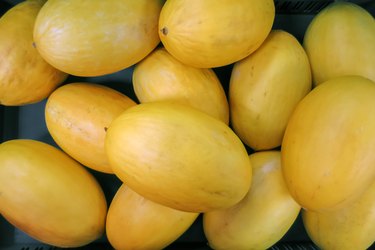
A type of winter melon, canary melons (Cucumis melo) are mild-tasting bright yellow melons rich in vitamins A and C. Unlike some other types of melons, the canary melon does not separate from the vine on its own when it is ripe. Therefore, you will need to note the color and feeling of the skin to determine if a canary melon is ready to pick.
What Are Canary Melons?
Video of the Day
Also known as Spanish melon or Juan canary melons, canary melons are considered a specialty melon. The fruit of these plants is oblong-shaped with a bright yellow rind and cream-colored flesh. The flesh of a canary melon is reminiscent of a pear in taste as well as texture. Canary melons, like other winter melons, lack the aromatic properties of muskmelons (known as cantaloupes in the United States) and are therefore described as "inodorous." A fully ripe canary melon weighs 4 to 5 pounds.
Video of the Day
Growing Canary Melons
Soil with a pH of 7.0 is ideal for growing any winter melon, Juan canary melons included. Melons require large quantities of nutrients, so it is a good idea to conduct a soil test to determine which if any nutrients may be missing and if fertilizer is necessary. Adding compost to the soil is also recommended prior to planting. Plan on side-dressing the plants with nitrogen when the stems, or runners, emerge.
Seeds can be sowed directly into the garden bed once soil temperatures have reached 65 degrees Fahrenheit. Winter melons take longer to mature than muskmelons, so you may prefer to start the seeds indoors about three weeks before the last frost and then transplant them.
Melon plants grow best in full sun and need about an inch or two of water a week. A layer of black plastic mulch around a canary melon plant can help conserve soil moisture and also limit weed growth. However, these mulches should only be applied once soil temperatures have reached 75 degrees Fahrenheit; otherwise, it can delay the warming of the soil. When the fruit begins to ripen, reduce watering, as this will enhance the flavor of the melon.
Harvesting a Canary Melon
Once a winter melon plant flowers, it takes about 45 days for the fruit to mature. If you have grown muskmelons, you know that the stem of the melon separates from the vine when the melon is ripe. This is known as abscission. However, this separation does not occur with winter melons, such as the canary melon.
To remove a canary melon from the plant, you must cut it off yourself. If you wait for the melon to separate from the vine, it will be too overripe when you harvest it. When a canary melon is ripe and ready to be picked, the skin will turn bright yellow and very waxy.
After harvesting, a canary melon can last for three to six weeks, which is longer than for cantaloupe. It is best to store canary melons at temperatures between 45 and 50 degrees Fahrenheit. Canary melons do not continue to ripen once they are removed from the plant.